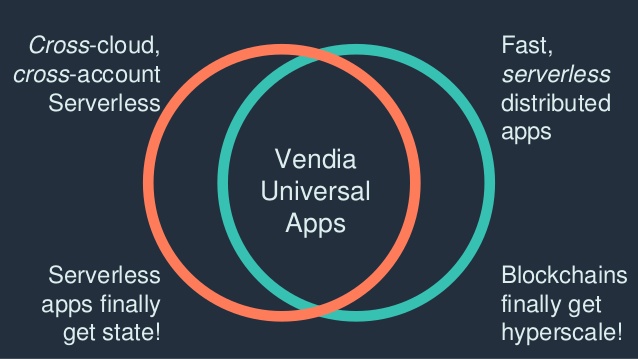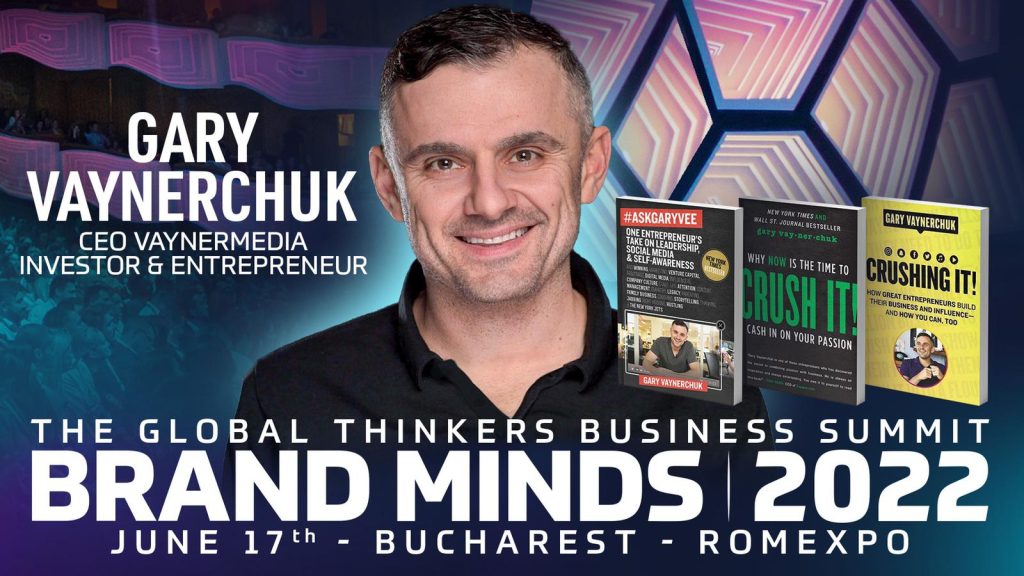Last days to join Business Strategy for Top Executives Masterclass with Costas Markides
Next week on March 23, 2021, founders and entrepreneurs, CEOs and investors, business developers and sales executives will participate in Business Strategy for Top Executives Masterclass with acclaimed Prof Costas Markides.
If you’re looking to turn your business from disrupted to disruptor and find innovative ways to thrive, then this masterclass is for you.
These are the last days you can get your tickets.

The masterclass is held online through live streaming. It starts at 9 am and ends at 5 pm with a Q&A session which is a great opportunity to get answers to your questions. An outside perspective over your particular situation is invaluable. It could light a new pathway that you couldn’t have seen otherwise.
Here is the agenda of Business Strategy for Top Executives Masterclass:
Session 1: STRATEGY IN A VOLATILE WORLD
Success doesn’t come by chance or fall in your lap. It’s the result of a well-thought strategy and an excellent implementation plan.
You know how they say about overnight success?
This overnight success has taken ten years of hard work and perseverance.
That’s why you need a strategy for your business. And given the volatile nature of the world we are living in, even more so today.
Every successful business has a successful strategy. Remember: strategy before tactics.
Amazon’s main strategy is to focus on their customers. But the global leader of the ecommerce market doesn’t just listen to its customers.
Year after year, since 1997, Amazon sets out to delight its customers.
And that’s the drive pushing every improvement and product or service that the company has ever made: its search recommendation engine, AWS, one-click purchase, Alexa and so on.
Join the masterclass to upgrade and improve your business strategy!
Session 2: STRATEGIC AGILITY IN TODAY’S WORLD
There has never been a better time to go agile in business. Times are changing quickly and the business environment must adapt and keep up.
In 2014, consulting company McKinsey & Co introduced two new dimensions to their organisational surveys: speed and flexibility.
They described the companies that combined both as agile.
Companies that are agile can adapt quickly to new challenges and opportunities. They mobilize quickly and show a strong relationship between organizational health and the creation of value. They move to market faster than traditional companies and have lower costs.
Join the masterclass to discover ways to create strategic agility for your business!
Session 3: MOBILIZING THE WHOLE ORGANISATION FOR STRATEGY EXECUTION
Whether you lead a business of thousands of employees or a small team of five, you need to be aware that for the strategy to work, everyone must be on board.
Every employee, from front desk to product development to supplier quality has to understand the strategy, contribute to its implementation and be on the same page with everyone else.
Learn from strategy expert Costas Markides how to mobilize your organisation for strategy execution.
Session 4: NEW CHALLENGES FOR LEADERS
One of the abilities that successful leaders need to develop or acquire is the ability to see around the corner.
What does that mean?
It means to have one foot in the future.
It implies to be able to spot trends before they go mainstream and take steps to leverage them to the benefit of your business.
It’s called strategic foresight. Strategic foresight allows companies to prepare for the future.
What challenges do leaders have to face in the near future?
Is it employee high turnover due to low engagement levels in the context of the work-from-home situation?
Everything going digital and online?
Changes in customer behaviour?
Attend the Business Strategy for Top Executives to find out!
Join the Conversation
We’d love to hear what you have to say.
Get in touch with us on our LinkedIn Page, Facebook Page, Twitter or TikTok.
Blockchain Business News 8-14 February
Stay updated with the latest blockchain news in business: subscribe to our blog notifications!
The blockchain technology market will grow at almost 63% CAGR through 2026 reaching $52.5 billion
According to ResearchAndMarkets’ latest report on blockchain, the blockchain technology market will grow at 63% by 2026 to $52.5 billion.
Important findings for the business environment:
- Distributed ledgers and other blockchain capabilities are rapidly expanding outside finance;
- The preponderance of blockchain revenue will be derived from 3 types of services: Blockchain-as-a-Service (BaaS), Cloud Computing (hosting and data as a service), and Systems Integration;
- Companies like Accenture will lead the charge for systems integration and companies like Amazon, Dell, HPE, and IBM will lead for BaaS and Cloud Computing;
- Integration and operation of Blockchain technology will redefine how various industries operate, dramatically improving efficiencies, and reduce the cost of doing business.

Blockchain fixes the ‘problem of paper’ in the bank guarantee process
In 2019, IBM and three of Australia’s finance heavyweights announced the formation of Lygon, the blockchain-based platform for bank guarantees.
Lygon is touted by the group as reducing the time to issue a bank guarantee from up to one month to one day.
The Lygon platform runs on the IBM public cloud and it leverages the IBM Blockchain Platform, which is built on top of Hyperledger Fabric, an open-source blockchain project from the Linux Foundation.
On February 9, Lygon announced minting the industry’s first standardised digital bank guarantee which solves the problem of paper.
What is the problem of paper?
Lygon CEO Justin Amos explains:
“Paper is slow, this is why we use emails; paper is expensive, and it’s estimated there are over 1 million journeys alone in Australia transporting paper guarantees. {…} Paper often gets lost and can be easily spoilt, subject to fraud, and problematic to amend.” “We shouldn’t underestimate the environmental impact of using paper,” he added.
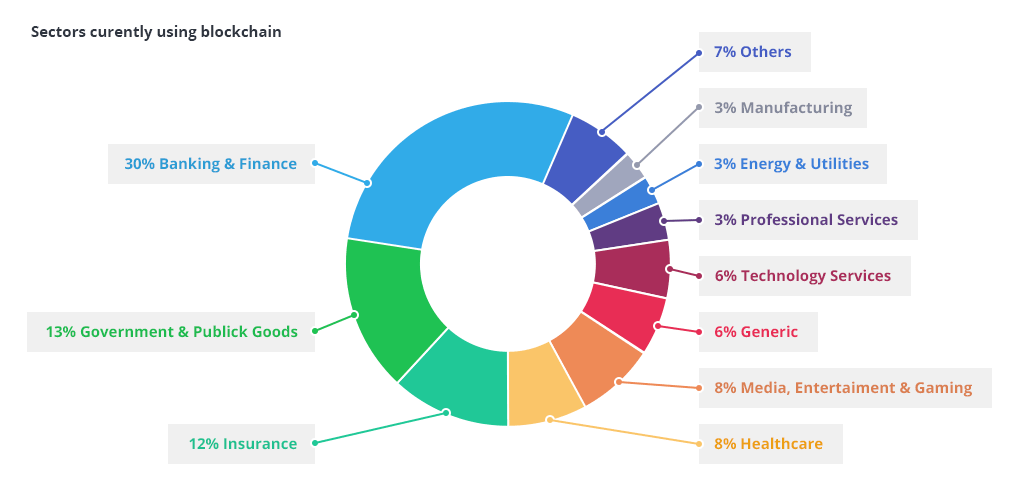
source: dzone.com
BMW backs enterprise blockchain startup Vendia in $15.5m Series A
Vendia is a multi-cloud serverless platform for sharing distributed data in real-time.
The blockchain technology startup has recently announced it had raised a $15.5 million Series A funding round for its serverless SaaS blockchain solution, bringing total funds raised to more than $20 million. One of its investors is BMW i Ventures.
BMW i Ventures is the corporate venture capital arm of BMW and has been actively investing since 2011. With an initial venture capital of 100 million dollars, BMW i Ventures invests in cutting-edge solutions focusing on BMW’s current and future business in the technology and customer & service space.
The team at BMW i Ventures manage investments in technology companies in the US, EU and Israel.
Here are some of the companies the venture capital firm has invested in:
- Verusen is AI-based inventory optimization software;
- Zendrive leverages mobile sensor data to provide actionable insights that improve safety for drivers worldwide;
- Urgent.ly is BMW’s vendor partner for roadside assistance;
- STRIVR platform utilizes immersive VR to help individuals learn faster and more effectively.
Blockchain payments Startup Celo Raises $20M
Celo is a global payments infrastructure that makes financial tools accessible to anyone with a mobile phone.
The platform is a proof-of-stake blockchain built on Ethereum, designed to support stablecoins and tokenized assets while utilizing mobile numbers to secure a user’s public keys.
According to the company’s latest press release, Celo has raised $20 million from renowned investors like a16z (Andreesen Horowitz), whose previous investments include Facebook, Slack, Asana, Lyft and more.
Since its launch in 2017, Celo developed a mainnet, a native token (CELO), a stablecoin (cUSD), a mobile payments app and has been listed on major exchanges including Coinbase and Binance.

source: techcrunch.com
Blockchain technology to be used against counterfeit products in China
Future FinTech and China Foundation of Consumer Protection have announced they signed a cooperation agreement to use blockchain technology against counterfeit products. The cooperation will expire on January 31, 2026.
Future FinTech is a leading blockchain e-commerce company and a service provider for financial technology. The company’s operations include a blockchain-based online shopping mall platform, Chain Cloud Mall, a cross-border e-commerce platform (NONOGIRL) and an incubator for blockchain-based application projects.
Cloud Chain Mall is the first C2C blockchain shopping mall operated with blockchain anti-counterfeiting tracing technology.
The goal of this agreement is to build the quality and safety credit system for Chinese brands and enterprises and protect the legitimate rights and interests of the enterprises and their brands.
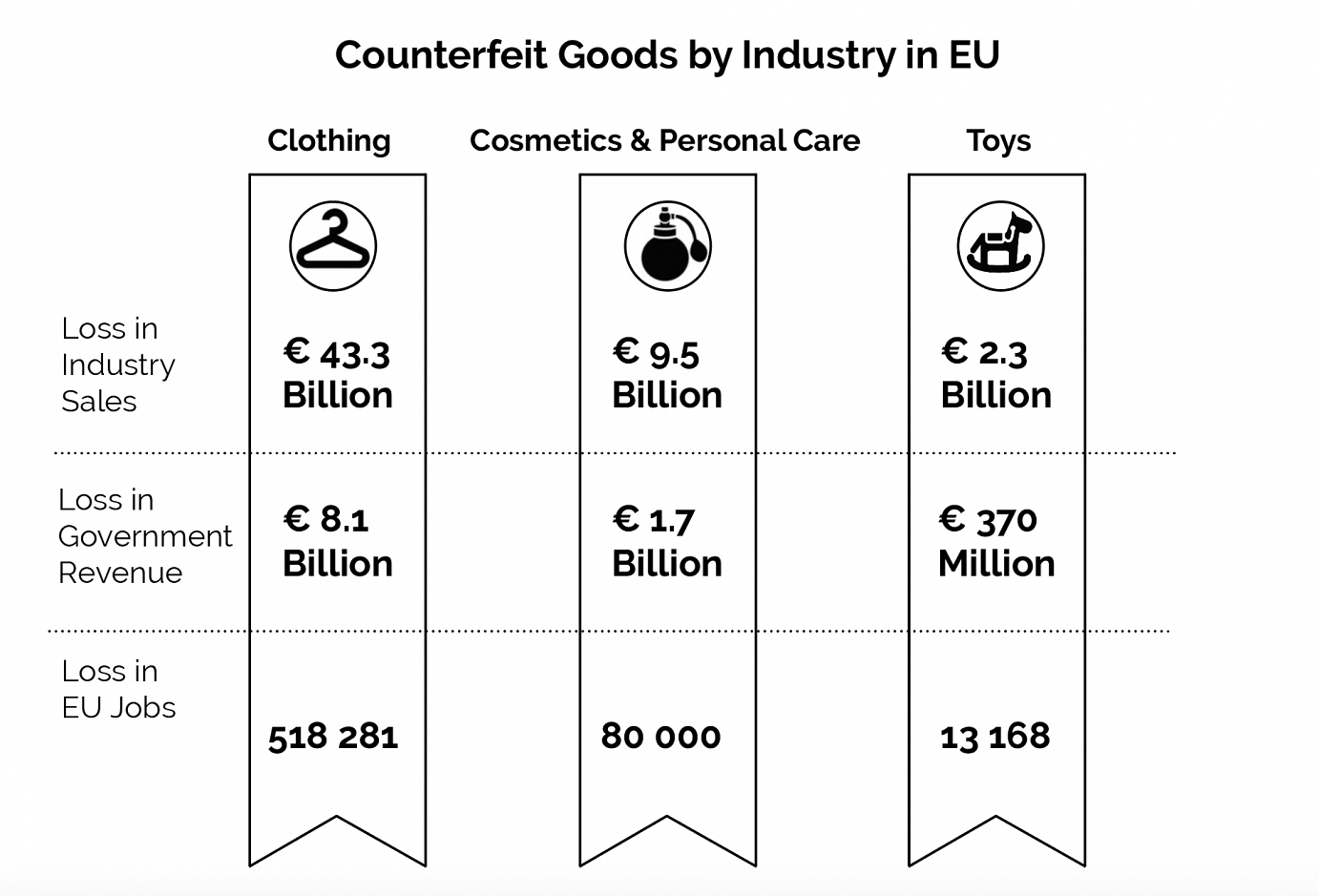
source: Bologna Business School
Quote of the week
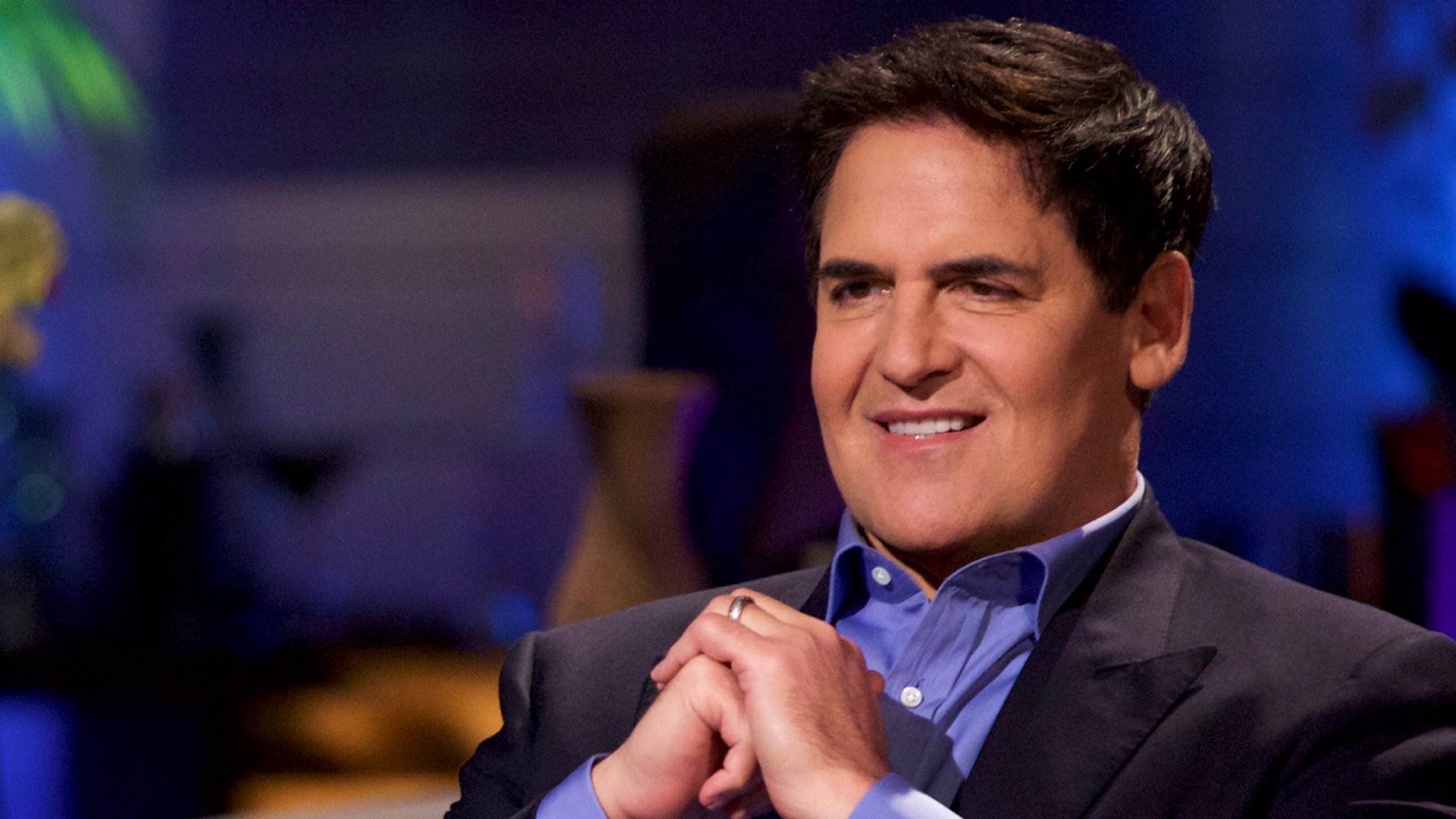
Marc Cuban / source: Inc. Magazine
It’s like the early days of the internet’ when a lot of people thought we were crazy
Investor and self-made billionaire Marc Cuban on blockchain
Join the Conversation
We’d love to hear what you have to say.
Get in touch with us on our LinkedIn Page, Facebook Page, Twitter or TikTok.
What is the McKinsey 7S framework for successful management
What is the McKinsey 7S model explained briefly?
The McKinsey 7S model is a business framework to address the essential role of coordination, rather than structure, in organizational effectiveness.
This business framework states that the organization is not the structure and is a model of organizational change.
Whenever organizations need to adapt to new business environments the hierarchy of the organization (who is tasked with what, who reports to whom, who needs approval from whom etc) is irrelevant.
The organization goes beyond its structure. It’s a complex ecosystem comprised of seven factors which interact with each other and influence an organization’s ability to change.
What are the 7S of McKinsey’s framework?
The seven factors of the McKinsey 7S framework are STYLE, SKILLS, SYSTEMS, STRUCTURE, STAFF, STRATEGY and SHARED VALUES.
For an organization to change successfully, it needs to approach every S factor.
The framework shows that every factor interacts with the other six. The organization cannot make significant progress towards change by focusing on one area and ignoring the rest. The organization must tackle its approach to change by moving into all seven S factors.
Let’s explain every S factor of the McKinsey model.
McKinsey 7S framework – Style
By style, the authors of the McKinsey 7S framework mean culture.
What is organizational culture and why is it essential to an organization’s success?
The culture of a company or organization is a set of shared beliefs, values and practices. The organization’s CEO, founder or top management are responsible for outlining the organization’s culture and hiring the right people that will maintain it.
For many organizations, culture drives success.
Neflix’s No rules policy is at the heart of its culture. The famous entertainment company nurtures employee freedom and encourages responsibility.
At UiPath, the efforts of top management are focused on providing employees with psychological safety beyond anything else.
At Amazon, employees are encouraged to think like an owner.
In every one of these organizations, success is synonymous with innovation and culture is the medium that facilitates innovation.
McKinsey 7S framework – Skills
Skills refers to organizational skills as well as individual skills.
What does your organization do best? What is your organization known for? What are its strengths? Is it creativity and design? Is it distribution or sales?
BMW is known for its innovative engineering and fast engines.
Coca-Cola has one of the most successful distribution systems in the world.
Louis Vuitton is renowned worldwide for its high-quality luxury handmade handbags.
The skills factor is also important to reveal skills gaps in the organization. With the business environment being disrupted by new technologies, organizations face increasing needs to fill skills gaps. They can either hire highly-specialized talent or upskill their current employees.
Another question that organizations must aks is do we need to improve hard skills or soft skills?
It’s an important question because the needs of an organization may shift every few years to follow changes taking place in our society. Read about the top 5 most in-demand soft skills in 2021.
Marketing is an industry where learning never stops. The professional growth and career advancement of a marketer now hinge on his or her desire and ability to learn new things. Read 4 skills that every successful marketer should acquire in 2021.
McKinsey 7S framework – Systems
By systems, the McKinsey framework means all the procedures, formal and informal, that make the organization go day by day.
How does the organization get things done?
Here are some of the main systems that an organization operates to achieve its goals:
- IT
- Financial
- Hiring
- Customer service
- Product development and delivery
- Information management
- Internal communication
- Planning
- Employee evaluation
There is a significant difference between how organizations were doing customer service in the 1980s and how it’s done today.
Organizations nowadays have a slew of digital tools they can use to solve the customer’s requests efficiently – Chatbots, Whatsapp, social channels etc.
McKinsey 7S framework – Structure
The structure factor of the McKinsey 7S framework refers to the way the organization is structured.
Is it centralized, decentralized or a hybrid?
Historically, the first organizations were centralized with one man, ie the founder or the CEO, taking every decision.
Apple under Steve Jobs is an example of a centralized organization where the founder made decisions regarding design, functionality, features etc.
The centralized organization can be very effective and ensures that the founder’s vision is carried out throughout the company and reflected in the product. But when the organization scales up, this type of organizational structure reveals its flaws. The organization is slow to make decisions and adapt to changing circumstances.
Starting with the 1950s, decentralization became the focus of organizations which had achieved a certain level of size and complexity.
Within these organizations, the number of employees had increased and subsequently the number of interactions required to make things work. The size and complexity of these organizations had become a burden and they were in danger of breaking down.
Decentralization was the solution. A decentralized organization is able to make decisions fast and adapt swiftly to its environment.
Other organizational structures are the line structure, the functional structure, the line-and-staff structure, the project-based structure, the matrix structure etc.
McKinsey 7S framework – Staff
Staff refers to the people in the organization and looks into the ways the organization nurtures and develops its employees.
How does the organization motivate its employees? What strategy does the organization employ to hire for diversity? Once diversity achieved, does the organization have an inclusion strategy?
Workforce diversity is a competitive advantage. A team which includes members of different generations, background cultures, interests and talents provides the organization with different insights and perspectives and drives creativity.
McKinsey 7S framework – Strategy
Strategy is defined as the actions a company plans to take to achieve its business objectives.
The plan outlines what (resources), how (specific tools, activities, platforms etc) and why (the reasons behind your choice of a specific resource or tool) the company will use to achieve its goals.
The strategy’s secondary goal is to define how the organization differentiates itself from the competition and create unique value. Learn how to create a strategic plan in 5 steps.
A successful organization must be able to change its strategy to match the current business environment. When organizations fail to see the need to change, they miss out on the opportunity to adapt and survive.
Nokia’s culture of status, shared fear and temporal myopia made the company vulnerable to competitive forces and prevented it to adapt its strategy (more on this in Why did Nokia fail?).
Microsoft, on the other hand, learned from Nokia’s mistakes (Microsoft acquired Nokia in 2014). When Satya Nadella became CEO, his main leadership challenge was to change the company’s culture. In his opinion, “The C in CEO stands for Culture”.
McKinsey 7S framework – Shared values
What is the organization trying to achieve? What is the organization’s social mission? How does the organization respond to the question Why?
In 2009, best-selling author Simon Sinek defined the concept of Why as the purpose, cause or belief that drives every one of us, leaders and employees alike.
Google’s mission is to organize the world’s information and make it universally accessible and useful.
TikTok’s mission is to inspire creativity and bring joy.
BRAND MINDS’ mission is to unite the business world by providing world-changers with the ultimate business experience.
Having a clear mission statement and delivering on it is paramount for a company’s reputation and bottom line. Consumers and employees expect organizations to stand for something. When they fail to deliver, organizations are met with protests and call-outs. For some organizations, change is now coming from employees putting pressure on the management, not the other way around.
Join the Conversation
We’d love to hear what you have to say.
Get in touch with us on our LinkedIn Page, Facebook Page, Twitter or TikTok.
5 steps to create a strategic plan that will support your business vision
In this article:
-
What is strategic planning in business: definition of the strategic plan, who creates a strategic plan, the main goal of a strategic plan;
-
Strategic plan vs Business plan;
-
Benefits of strategic planning;
-
The strategic planning process: 5 steps to create a strategic plan that will support your business vision.
1. What is strategic planning in business?
Strategic planning is an organizational management activity. The company’s CEO and senior leadership team are tasked with creating a strategic plan, it’s one of their responsibilities.
The goal of a strategic plan is to provide you with a roadmap to align the organization’s functional activities to achieve set goals and determine the direction in which you want to take your business.
The plan outlines what (resources), how (specific tools, activities, platforms etc) and why (the reasons behind your choice of a specific resource or tool) the company will use to achieve its goals.
The main goal of your strategic plan is differentiation
The main goal of the strategic plan you create for your business is to define how your business differentiates itself from the competition.
What activities is your business performing that are different from the activities performed by your competitors?. Or what activities that are similar to your competitors’ you perform differently?
Harvard professor and author of Porter’s 5 Forces Michael Porter defines strategy as “performing different activities from others or performing similar activities in a different manner.”
Nikki Reed’s jewellery – a case study on business differentiation
Twilight series actress Nikki Reed designs beautiful jewellery. Her collections include 14-18 karat gold pieces. As opposed to other jewellery designers, her collections are made from e-waste.
Nikki’s business goal is to produce jewellery that is ethically made, sustainable and chemical-free. To achieve her goal, she partnered with computer technology company Dell.
According to the latest stats, it is estimated that our smartphones contain more than $60 million in gold and/or silver which are thrown away every year. Dell has developed a process for extracting gold from old computer motherboards that is 99% more environmentally friendly than extracting gold from the earth.
That’s how Nikki Reed differentiates her business from competitors: by using gold responsibly extracted from recovered technology to make beautiful jewellery. See her collections.
2. Strategic plan vs Business plan
A strategic plan is for established businesses looking to grow by providing them with focus, direction and action. Whereas a business plan is for businesses starting out and provides the entrepreneur with a structure for his ideas defining the business.
A strategic plan generally covers a period of 3 to 5+ years, whereas a business plan is normally no more than one year.
Discover more differences between a strategic plan and a business plan.
3. Benefits of strategic planning
No matter how much you wished your business had no competition on the market, your competitors are not going away just because you wish them to.
What you could do, after a thorough analysis of your business, the market and your competition is to devise a strategy that would help your business achieve its goals by doing things differently.
By having a strategic plan in place the top management conveys trust to the company’s employees.
A clear path to achieving set business goals means the team is more likely to enjoy an increased level of focus, determination and creativity.
Success is more easily achievable when everyone knows what to do and how to do it.
4. The strategic planning process
Before going into the strategic planning process, the CEO and top management have to be clear on the company’s vision, mission and organizational goals and objectives.
The CEO or founder is responsible for creating the vision and formulating the mission. The business vision states why you do it while the business mission states what your company does to achieve its vision.
The vision statement provides a snapshot of what the world would look like as a result of the company’s services. The mission statement is the roadmap for the company’s vision statement.
Let’s look at the vision and mission statements of a number of companies whose products and services you might use on a daily basis.
Vision – To provide access to the world’s information in one click.
Mission – Our mission is to organize the world’s information and make it universally accessible and useful.
AMAZON
Vision – We aim to be Earth’s most customer-centric company.
Mission – Our mission is to continually raise the bar of the customer experience by using the internet and technology to help consumers find, discover and buy anything, and empower businesses and content creators to maximize their success.
SALESFORCE
Vision – Salesforce is the world’s #1 customer relationship management (CRM) platform.
Mission – We bring companies and customers together. We help your marketing, sales, commerce, service and IT teams work as one from anywhere — so you can keep your customers happy everywhere.
Did you know? SalesForce has recently announced that it will acquire Slack for $27.7 billion.
TIKTOK
Vision – TikTok is the leading destination for short-form mobile video.
Mission – Our mission is to inspire creativity and bring joy.
5 steps to create a strategic plan that will support your business vision
A company’s vision and mission are not set in stone. Your business may transform as a result of technological developments or customer behaviour changes. For this reason, it is important to revisit the company’s vision and mission and amend them if necessary.
- Market analysis
- Development
- Implementation
- Review and update
- Evaluation and measurement
Step 1 – Market analysis
Before anything else, it is important to get updated on the current status of your business.
Perform a SWOT analysis to see if there are changes in your company’s strengths, weaknesses, opportunities and threats?
Are there new threats looming over the business ushered in by the pandemic?
Can you turn a new threat into an opportunity?
How is the pandemic affecting your bottom line?
Next, apply PORTER’s 5 Forces framework to your industry to evaluate how the pandemic is influencing the drivers of profitability and competition in your market. Get your team together and discuss what valuable insights you can take away from this analysis. How could these insights help you come up with a specific and unique way in which to delight your customers today?
PESTEL is another great tool that you can use to understand the impact of macro-environmental factors on your business. The PESTEL acronym stands for Political, Economical, Social, Technological, Environmental and Legal.
How are these factors that you cannot influence, affecting your business?
Check out a PESTEL analysis of Nike
Once you have drawn relevant insights from your company and business market analysis, you can move to step 2 of the strategic plan: development.
Step 2 – Development
Sit down together with your team and write the strategic plan.
Include the following:
- Company description
- Mission, vision and value statements
- Strengths, weaknesses, opportunities and threats
- Describe the current drivers of profitability and competition (PORTER’s 5 Forces)
- Describe how the macro-environmental factors impact your business (PESTEL)
- Prioritize your objectives
- Determine your strategic position (ie: at least one way in which your business will differentiate itself from the competition)
- Describe in great detail how you are going to leverage your newly developed strategy to achieve your business goals (means of communication, resources, budget etc)
- Include an execution timeline and how you are going to measure success
- Review and revise the plan.
Step 3 – Implementation
Now that you have the strategic plan on paper it’s time to execute it.
But before that, you need to communicate your plan to the employees that are going to implement it.
Choose the best way to do that. Is it a lengthy email? Or an all-hands meeting?
Prepare yourself to answer questions and convey your vision as clearly as possible.
You might also need to provide inspiration and motivation.
Step 4 – Review and Update
Determine when to review the strategic plan over the course of the implementation and go back to the plan to update it if necessary: 3 months? 6 months?
Step 5 – Evaluation and measurement
Once the strategic plan has been executed, it’s time for evaluation and measurement.
Extract the results and measure them against your set projections.
Calculate the KPIs and ROI.
Did the strategic plan help your business to achieve its set objectives?
Join the Conversation
We’d love to hear what you have to say.
Get in touch with us on our LinkedIn Page, Facebook Page, Twitter or TikTok.
6 marketing goals you should set in 2021 to support your business vision
6 marketing goals you should set in 2021 to support your business vision
-
Increase brand awareness
-
Empower your email subscribers
-
Build brand ambassadors
-
Boost your sales through referral programs
-
Identify customer behaviour change
-
Increase website traffic with guest content
Let’s talk about each of them.
1. Increase brand awareness
If a stranger approached you in the street offering to be your friend would you accept? I can’t speak for you but I’m sure my answer would be I can’t be friends with someone I don’t know.
It’s the same with your brand: why do expect your customers to buy your products if they are not aware of your brand? That’s why brand awareness is an essential part of brand building. Brand awareness is a process leading to sales. The first stage of an effective sales funnel is awareness followed by interest, decision and action.
Brand awareness is also an ongoing process. Coca-Cola is the leading global soft drinks company and has been on the market for 128 years. You would be hard-pressed to find someone who hasn’t drunk a bottle of Coke in their life or is unable to recognize the brand’s iconic logo. This happens thanks to the company investing billions of dollars in campaigns. More precisely, $4 billion each year since 2015 to market its drinks to consumers around the world. If the company didn’t commit to this goal of maintaining and increasing brand awareness year after year, it would quickly lose the top spot and market share.
So how do you increase your brand’s awareness? It certainly helps to have a big budget but that’s not everything.
Let’s explore ways that you can increase awareness for your brand!
Share of voice
Marketing effectiveness expert Les Binet recommends that brands should run both sales activation and brand building campaigns but tweak the balance to 75% brand building and 25% activation.
Binet’s research found that sales activation delivers short-term sales volume while brand-building campaigns lead to long-term growth and higher sales volumes. Learn about brand awareness and why SOV (share of voice) is important for your brand (with examples).
Partnerships
As a business owner, you are competing with other businesses in your market for the attention of your customer base. What if you took a different approach and choose to build brand partnerships instead of competing with each other?
Here are 9 benefits of brand partnerships:
- Sharing customer bases;
- Break into new markets;
- Cross-selling;
- Expanding your customer base;
- Lead-generating opportunities;
- Brand strengths are amplified through collaboration;
- A great experience for the customers;
- Enhanced brand awareness and exposure.
If you decide that partnering is a good strategy for your company, there are factors you need to consider for a successful brand partnership before you draft your first contract.
Standing up for your brand’s values
Brands are no longer setting the pace for its consumers. In fact, it’s the other way around – consumers have the upper hand over brands.
Over the past few years, consumer behaviour reports have highlighted this fact: it’s important for consumers to see their favourite brands act on their beliefs and values.
A 2018 study from Shelton Group found that 86% of consumers want brands to take a stand on social issues and said they’d purchase a product because a company advocated for an issue they cared about.
There are many examples of big brands taking a stand on social issues and receiving praise from the public (Nike’s Dream Crazy, UK supermarket chain Iceland and its Say Hello to Rang-tan ad, Barbie’s Close the dream gap) while other brands are facing backlash for failing to engage with their customers’ needs and expectations and their outdated marketing (Victoria’s Secret).
2. Empower your email subscribers
Email marketing done right outperforms social media in terms of reach, CTR, conversion rate and ROI.
And by outperforming ROI I mean 42:1 which means for every dollar spent, your company’s return is 42 dollars.
To get this high of an ROI, you need to focus on the words done right.
First, make sure you don’t make these 5 email marketing mistakes and second, update your buyer’s persona especially at the pain points and dreams categories.
What stands between them and their goals? What are they dreaming to achieve? What do they need to meet their objectives? Find out what they need and give it to them.
Of course, your email marketing strategy should include sales-focused emails, but maintain a balance between promotional content and non-promotional content. If you don’t know what that balance is, you can start with the 80-20 rule of thumb: 20% sales content and 80% empowering content.
Once you have identified what empowering content looks like for your customers, invest your resources into designing the ways in which to deliver that content. Infographics, video, expert quotes, listicles, how-tos, links to in-depth articles etc.
Find a way in line with your brand goals to reward your most engaged subscribers.
Also, create the opportunity for your subscribers to get to know each other. The end objective of your email marketing strategy is to empower your subscribers individually and transform them into a community.
3. Build brand ambassadors
In 2018, marketing software provider Hubspot said goodbye to the marketing funnel and hello to the customer flywheel.
The shift happened when the company noticed that customers were purchasing HubSpot products after they have been recommended by their friends, already HubSpot customers.
The situation was that word of mouth was selling HubSpot products instead of the company’s marketing efforts.
The customer flywheel is not a funnel but a process where customers feed growth. The Customer Flywheel leverages the enthusiasm of existing customers and turns it into a driving force for attracting new customers.
What makes the flywheel spin faster and faster? Increased force and reduced friction. The more force with less friction applies to the flywheel, the faster it spins.
Once the flywheel gains momentum, it can spin forever with little effort from the company. Momentum comes from retaining customers and transforming them into brand ambassadors leading to increased customer retention and brand loyalty.
Learn more about improving customer retention and loyalty.
4. Boost your sales through referral programs
A referral program is a word-of-mouth marketing tactic that encourages customers to advocate on behalf of your brand.
The purpose of a referral program is to attract new leads. Compared to other lead generation tactics, the leads that referral programs generate are better because their profile is more likely to match that of your customers.
This means more qualified leads and less time and resources used by your company to nurture and engage them.
Referral programs have higher chances to succeed because they leverage the power of peer-to-peer marketing and one of Cialdini’s Principles of Influence: social proof. The social proof principle states that people will look to the actions of others to determine their own. Man is by nature a social animal: we are influenced by our environment and our friends.
Statistics support this: 90% of consumers trust peer recommendations and only 33% trust ads (Nielsen).
Here’s how to build a customer referral program.
5. Identify customer behaviour change
Thomas Cook was the world’s first travel agency, one of the leading companies in the leisure travel industry present in 17 countries, owned an airline and operated thousands of hotels around the world.
In 2019, Thomas Cook ceased its operations leaving around 600,000 tourists overseas including 150,000 British citizens. It was the UK’s biggest peacetime repatriation.
One of the reasons that led to Thomas Cook’s failure was this: the company missed the opportunity to include Millennials among its customers.
When Millennials entered the market, it was obvious that the market had to change. The Millennials would rather take more short trips i.e. city breaks throughout the year rather than one big vacation package. Also, Millennials behaved differently than their parents or grandparents in that they planned their own itineraries, used digital tools (like Airbnb or Booking.com), focused on transformational experiences and were influenced by social media or user-generated content (source).
The company failed to acknowledge this change in behaviour and adapt its offer to cater to the needs of this new type of customer. This and other factors contributed to the failure of Thomas Cook.
6. Increase website traffic with guest content
Does your company use social media as a marketing channel? I’m pretty sure the answer is yes.
According to the latest statistics, 77.6% of small businesses report using social media to promote their businesses.
What would your company do if Facebook, Instagram or YouTube suddenly disappeared?
That’s right, all your efforts would have been in vain. It’s not to say that you shouldn’t use any social media channels for your company. Only that you shouldn’t invest all your resources in them.
What you should do is invest a large portion of your resources into driving traffic to your website. Remember that social media platforms are rented space whereas your website is owned, you control what happens in your house.
To increase your website traffic consider featuring guest content on your company blog.
Guest content is a great way to expand your reach and increase brand awareness.
In order to achieve this goal, it’s essential that you choose the right contributing authors for your brand.
Whoever you choose, note that your brand will be associated with that particular contributor.
Make sure that your brand’s values are aligned with your contributor’s values.
And most importantly: the best guest content contributor is the one that your audience follows organically.
Join the Conversation
We’d love to hear what you have to say.
Get in touch with us on our LinkedIn Page, Facebook Page, Twitter or TikTok.
Jeff Bezos: 8 business lessons from his letters to shareholders
According to recent industry figures, Amazon is the leading eCommerce retailer in the United States with 38,7% share of retail eCommerce sales (source).
Here are the latest Amazon statistics:
- $280.5 billion in net sales
- $11.59 billion in net income
- The most popular product categories: Electronics
- Number of paying Amazon Prime members worldwide: 150 million
- Share of US Amazon customers who are Amazon Prime members: 65%
- Unique monthly US visitors to Amazon sites: 208 million
- Share of direct traffic to Amazon.com: 56.47%
- US Amazon Prime Day conversion rate: 13.5%
- Average annual spending of Amazon Prime members: $1,400
- The most important reason for US shoppers to shop on Amazon: fast, free shipping
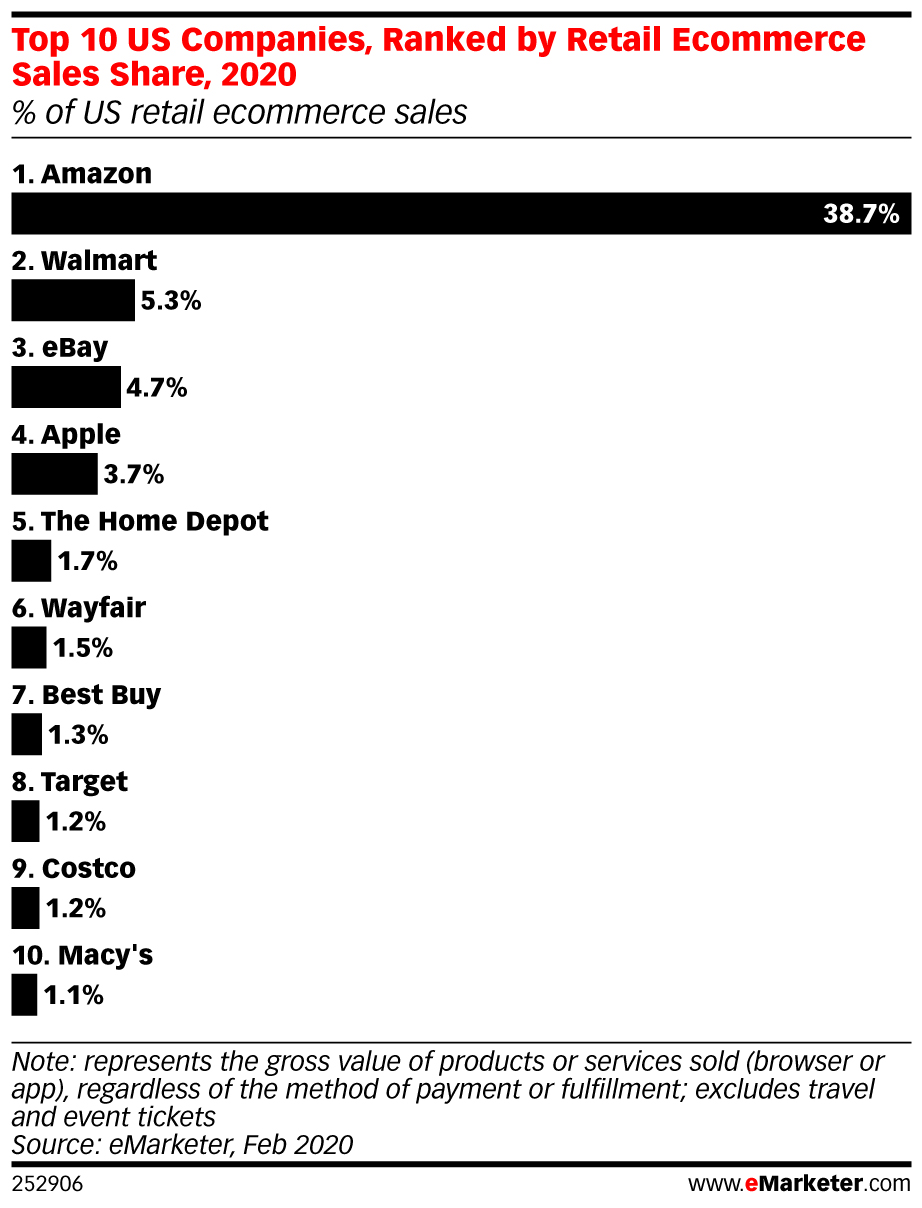
Amazon is #1 in the U.S. Let’s zoom out and take a global approach.
Is the giant retailer maintaining its top place when compared to other eCommerce retailers?
As you can see below, the answer is yes.
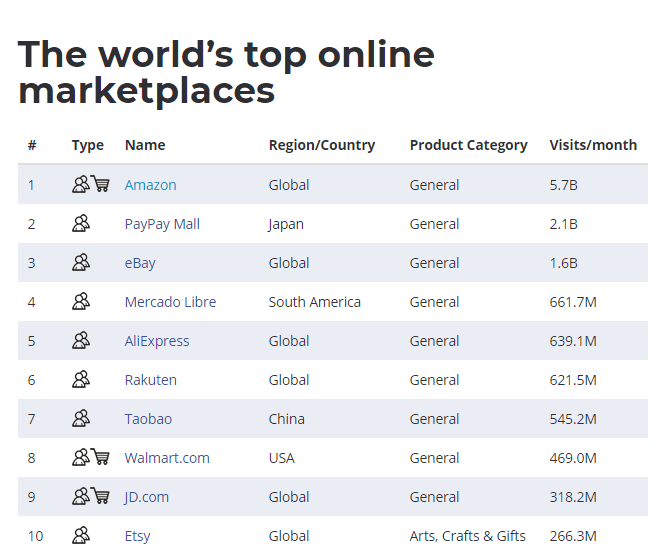
image source: webretailer.com
Amazon.com receives twice the monthly number of visitors as #2, the Japanese retailer PayPay Mall.
If the eCommerce retail industry were a marathon, Amazon would be the front runner, leading the other runners and winning by a landslide.
What makes Amazon so successful and powerful?
What drives this marathon runner to push harder year after year?
How is Jeff Bezos coaching the Amazon collective?
For the purpose of this article, I have analysed Jeff Bezos’ annual letters to shareholders from 2016, 2017, 2018 and 2019. As any Jeff Bezos fan knows, each of his letters ends with a copy of his famous 1997 letter so I have included it in my analysis.
Jeff Bezos: 8 business lessons from his annual letters to shareholders
1. Move quickly to solidify and extend your current position
At the end of 1997, in just three years since starting the company, Amazon.com’ revenue had increased by 838%, selling to more than 1.5 million customers while extending its market leadership in an increasingly aggressive competitive environment (source).
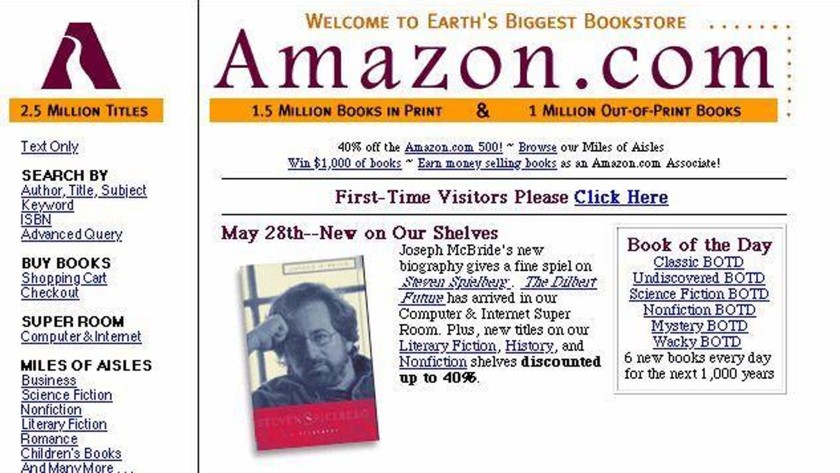
image source: latimes.com
1997 is the year Amazon filed to go public and was preparing to compete with big tech companies AOL and Microsoft which had announced their intention to derive a substantial portion of their revenues from online commerce.
I remind you that Amazon was still selling books at that time.
But that didn’t discourage Bezos who had a strong belief in the online opportunity as expressed in his 1997 letter:
We have a window of opportunity as larger players marshal the resources to pursue the online opportunity and as customers, new to purchasing online, are receptive to forming new relationships. The competitive landscape has continued to evolve at a fast pace. Many large players have moved online with credible offerings and have devoted substantial energy and resources to building awareness, traffic, and sales. Our goal is to move quickly to solidify and extend our current position while we begin to pursue the online commerce opportunities in other areas. We see substantial opportunity in the large markets we are targeting.
2. Set out to delight your customers
After reading Jeff’s letters, if I were to choose only one factor responsible for Amazon’s success it would be his focus on customers.
Complaining customers are a company’s most valuable resource for growth. They reveal blind spots that employees or managers could not otherwise identify giving the business the opportunity to improve and develop.
In his 2016 letter, Jeff says “customers are always beautifully, wonderfully dissatisfied, even when they report being happy and business is great.” In his 2018 letter, he defines them as “divinely discontent”.

image source: blog.aboutamazon.com
Achieving the goal of delighting customers means developing a powerful system built on true customer obsession.
So here’s the Amazon customer-focused trifecta:
- Listen to your customers and use this data to offer them something they simply could not get any other way
- Improving the shopping experience never ends so pursue it with tenacity and persistence
- Invent on behalf of your customers. Your customers will always want something better and it’s up to you to figure out what exactly it is they expect because, and here’s your challenge, they don’t know what to ask for.
We must invent on their behalf. We have to tap into our own inner imagination about what’s possible.
Jeff Bezos
That’s how AWS, one of Amazon’s most successful services came to be. No customer specifically asked for it and yet that’s what they needed. In 2019, AWS generated $10.2 billion in net sales, up 33% from last year.
Remarkable customer experience starts with heart, intuition, curiosity, play, guts, taste. You won’t find any of it in a survey.
Jeff Bezos
3. Make bold investment decisions
In his 1997 letter, Jeff talks about investments and the criteria underlining his investment decisions.
At the heart of Amazon’s investments is the customer. Every investment that Amazon makes is to further improve customer satisfaction and experience by developing systems, infrastructure and service.
Is the investment going to help the company come closer to its goal of achieving market leadership? Is the investment going to support the company achieve its long-term business objectives? If the answer is yes, then the investment gets the green light.
Always measure the effectiveness of your investments. Establish a set of KPIs to measure the results of your investments, discard the ones that don’t perform as expected and double down on the investments that work. Learn from both your failures and your successes.
If you see a sufficient probability of gaining market leadership advantages, go for it and be bold. There’s no need to start small, go bold!
4. Become aware of proxies
What is a proxy? Proxy is something or someone who acts as a substitute. In his 2016 letter, Jeff talks about the danger of allowing proxies to gain power within the company.
Have you ever heard someone say when referring to a bad outcome Well, we followed the process? That is when the process has become more important than the result and replaced it. It’s the process as a substitute for the outcome.
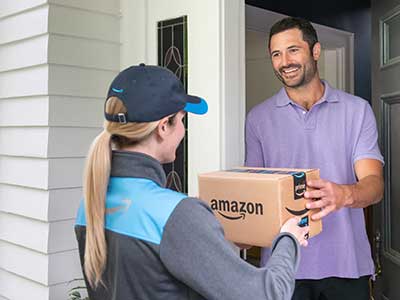
image source: amazon.com
This is a dangerous place for a company and could contribute to its downfall. Jeff’s advice is to become aware of any proxies influencing your business outcomes and eliminate them. Don’t allow market research and customer surveys to become proxies for your customers.
Good inventors and designers deeply understand their customer. They spend tremendous energy developing that intuition. They study and understand many anecdotes rather than only the averages you’ll find on surveys. They live with the design.
Jeff Bezos
5. Your employees must think like an owner
Jeff acknowledged early on that hiring the right people was paramount if Amazon was to be successful and achieve its objectives. “Setting the bar high in our approach to hiring has been, and will continue to be, the single most important element of Amazon.com’s success.”
Amazonians are committed to the company’s core values and goals. They are passionate about working to build something important, something that matters to their customers, something that they can all tell their grandchildren about. Jeff and his hiring team focus on attracting and retaining versatile and talented employees.
“When I interview people I tell them, You can work long, hard, or smart, but at Amazon.com you can’t choose two out of three”, Jeff said in his 1997 letter.

image source: amazon.com
How is Amazon motivating its valuable employees?
The company provides them with two options to choose from: receive compensation in Amazon stock or cash. The retailer would rather compensate its employees in Amazon stock than cash because becoming stockholders changes their mindset. Jeff expects employees to think and act like an owner. To achieve this, employees must actually be owners.
How do you support your employees to take ownership of their work? Do you believe employees thinking and acting like owners makes a difference in the quality of their work?
6. Embrace external trends
Today the business environment is shaped by a wide variety of external factors ranging from technology, online and digital to cultural shifts, changes in customer behaviour etc. Businesses that have adapted to these trends and transformed, as a result, survived. Businesses that have resisted change, didn’t.
Jeff talks about external trends and why businesses should embrace them in his 2016 letter. His advice to every company founder is to acknowledge powerful external trends and embrace them quickly.
Depending on the size of your organization, achieving this could be easy or difficult. It’s somewhat easier for a startup to embrace trends than for a large organization. That’s why it’s imperative for large companies to become agile.
When talking about external trends, Jeff is referring to machine learning and AI.
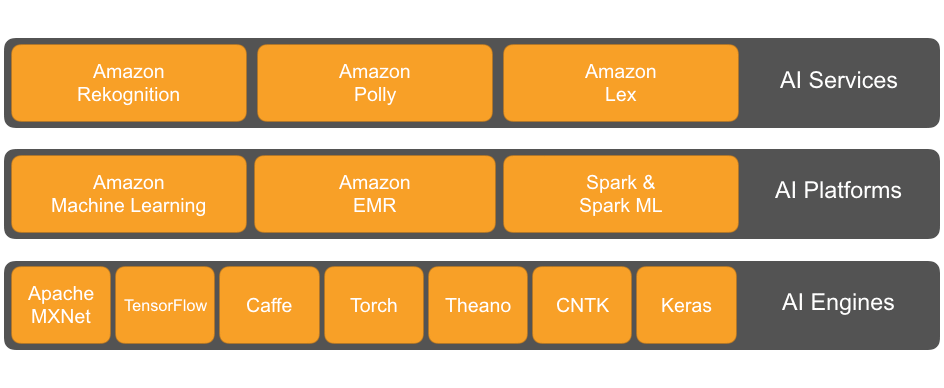
image source: aws.amazon.com
Amazon.com has been working on developing its own machine learning-powered recommendation algorithm since the late 1990s.
In 2003, the development team at Amazon published a paper describing a new recommendation algorithm. The recommendation algorithm they created was called the item-to-item collaborative filter and allowed the online store to radically change for each customer based on their interests.
A 2013 McKinsey article reported that Amazon’s machine learning engine was responsible for 35% of its online sales. I’m sure this number is higher today.
Jeff points out that machine learning drives Amazon’s algorithms for demand forecasting, product search ranking, product and deals recommendations, merchandising placements, fraud detection, translations.
But much of the impact of machine learning is less visible but equally important. Machine learning and AI have a prominent role in the company’s future.
7. Make high-quality decisions fast
Amazon is leading the global eCommerce landscape falling back on 26 years of experience in the industry. It’s one of the big five tech companies, FAAMG—Facebook, Amazon, Apple, Microsoft, and Google and the largest employer among them, with 840,000 employees.
Large organizations have many things going for them (attracting talent, high-value wages, global development, technology advancements etc) with one downside: they are slow at making decisions.
Jeff calls these established large organizations Day 2 companies. Day 1 companies are startups, nimble and agile, bursting with vitality. Day 2 companies are already heading for the end.
Day 2 is stasis. Followed by irrelevance. Followed by excruciating, painful decline. Followed by death. And that is why it is always Day 1.
Jeff Bezos
Twenty-six-year-old Amazon is technically a Day 2 company but with a Day 1 mindset. It’s what allows the giant retailer to keep the energy and dynamism of a lean startup while being #1 in the global eCommerce industry.
How do you make high-quality decisions fast?
Jeff gives the following pointers in this regard:
- Never use a one-size-fits-all decision-making process;
- Make decisions with around 70% of the information you wish you had. If you wait for 90%, in most cases, you’re probably being slow;
- Be good at quickly recognizing and correcting bad decisions. Being wrong may be less costly than you think, whereas being slow is going to be expensive for sure;
- Recognize true misalignment issues early and escalate them immediately;
- Use the phrase “disagree and commit”. If you have a conviction on a particular direction even though there’s no consensus, ask everyone else to gamble with you on it and you’ll probably get a quick yes.
Choose to have the scope and capabilities of a large company and the spirit and heart of a small one.
Jeff Bezos
8. Implement high standards
Staying ahead of the ever-rising customer expectations is one of Amazon’s objectives.
The giant retailer’s obsession with customer satisfaction has led to a number of product innovations (Alexa, AWS) and excellent customer experience (Amazon Go, the no checkout lines physical store, Prime Air, Amazon’s 30-minute delivery service via drones, one-click purchases).
What does it take to achieve such results?
A high-standard mindset.
Here’s what Jeff says about implementing high standards in your company:
- Expose your people to high standards. High standards are teachable and contagious;
- Articulate a few core principles of high standards which helps accelerate the rate of learning;
- Teach high standards in every arena of interest. High standards are domain-specific;
- Recognize the standard and have realistic expectations on scope. To achieve high standards yourself or as part of a team, you need to form and proactively communicate realistic beliefs about how hard something is going to be.
What are the benefits of high standards?
Building better products and services for customers, recruiting and retaining talent and teaching employees how to be professional starting with doing the most invisible work.
People have a voracious appetite for a better way, and yesterday’s ‘wow’ quickly becomes today’s ‘ordinary’.
Jeff Bezos
Join the Conversation
We’d love to hear what you have to say.
Get in touch with us on our LinkedIn Group, Facebook Group or Twitter.
David Meltzer (co-founder & CEO of Sports 1 Marketing): The most successful ventures are those who evolve over time
David Meltzer is the co-founder and CEO of Sports 1 Marketing, top executive business coach and keynote speaker.
His company Sports 1 Marketing is a global sports and entertainment marketing agency that leverages over $20 billion in relationship capital and over 38 years of business experience.
David is a brand, media and business advisor at Youcanevent.com, an early-stage startup with more than half-million dollars in sales generated for hundreds of vendors in the last 12 months.
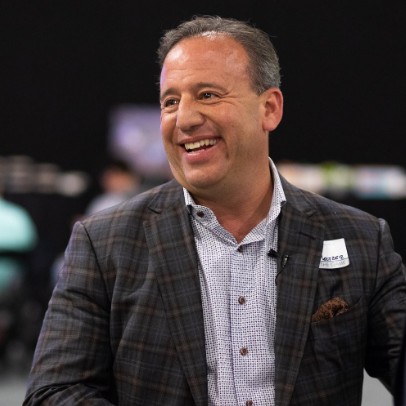
David Meltzer
He is also chairman of Unstoppable Foundation, a non-profit humanitarian organization bringing sustainable education to children and communities in developing countries.
In 2017, David joined Entrepreneur Elevator Pitch TV series as an executive producer and judge. The show has been running for five seasons with great success.
He has also been recognized as “Sports Humanitarian of the Year” by Variety.
This year, he published his latest book ‘Game-time decision making – High-scoring business strategies from the biggest names in sports’, which teaches readers how to make business decisions with the same confidence and clarity as the world’s best sports coaches.
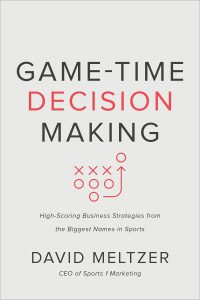
As a successful businessman, David takes to social media to share his insights and provide value to help other entrepreneurs starting out. Follow him on his channels but also tune in to his podcast The Playbook where he talks to people in top management roles at various companies.
I reached out to David Meltzer with a few questions on topics highly relevant in today’s business environment.
Find his answers below.
1. Nokia failed because of its fear-fostering culture. Had it not been for Satya Nadella’s change in leadership style, Microsoft might have had the same fate. Building the right company culture is foundational to that company’s success. What factors should entrepreneurs take into consideration when building their company’s culture?
First, entrepreneurs should consider the relationship between the company’s mission and its core values. What exactly is your company’s mission and how are your core values used to accomplish that mission?
When I first started Sports 1 Marketing, my initial mission statements were convoluted and confusing. It was only after I consulted one of my fellow co-founders that I realized the need to simplify that mission, eventually settling on “Make a lot of money, help a lot of people, and have a lot of fun.”
From there, you need to develop a strategy to instil those values in employees and interns, consistently and persistently.
One of my favourite ways to reinforce company culture is with company-wide meetings or training, for example, our “Monday Morning Meetings” where our team gets together and participates in activities that revolve around our values.
One of the things we highlight for employees is being a “student of your calendar”, so the entire company goes through the calendar to identify possible issues and efficiencies, with employees and interns alike learning more about how we like to run the business.

image: David Meltzer Facebook Page
2. Today the workplace might include employees belonging to four different generations: people in their 60s, 40s, 30s and 20s. What is the entrepreneur expected to do to make sure everyone is happy?
I think the first thing is finding your “vibration”, meaning the frequency that you have and share with others. When you are authentic and vulnerable, this frequency will resonate with those around you, no matter what generation a person is from.
The next step comes when you understand the different ways we communicate and which generation prefers each.
There are three main components to communication, which I call content, access, and medium.
The content is what you are communicating to others, the access is how it is communicated, and the medium is where that content is communicated. When you have a grasp on the type of content that each generation prefers, as well as how and where it is communicated, you are better prepared to inspire your team members and empower them to be happy.
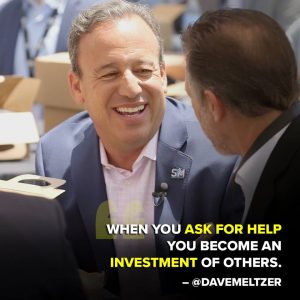
image: David Meltzer Facebook Page
3. What are the building blocks of your success in business?
When interns come into our office, they are often expecting to learn about what it takes to work in sports. The first thing I tell them is that we are going to teach them principles that would serve them in any industry, which are gratitude, empathy, accountability, and effective communication.
Gratitude gives you a positive outlook, making your past unbelievable, your present better, and your future brighter.
Empathy means forgiveness to me, and the person you need to live to forgive first is yourself because you cannot give to others what you do not have for yourself.
Accountability teaches us to ask two questions whenever something happens in our life: What did I do to attract this to myself and What am I supposed to learn about it?
Finally, effective communication requires us to connect in two ways, to those around us as well as to that which inspires us. When you are able to live with those values consistently and persistently, you will not only be successful, but happy.
[bctt tweet=”David Meltzer (CEO @Sports 1 Marketing): The building blocks of business success are gratitude, empathy, accountability and effective communication. ” username=”brand_minds”]
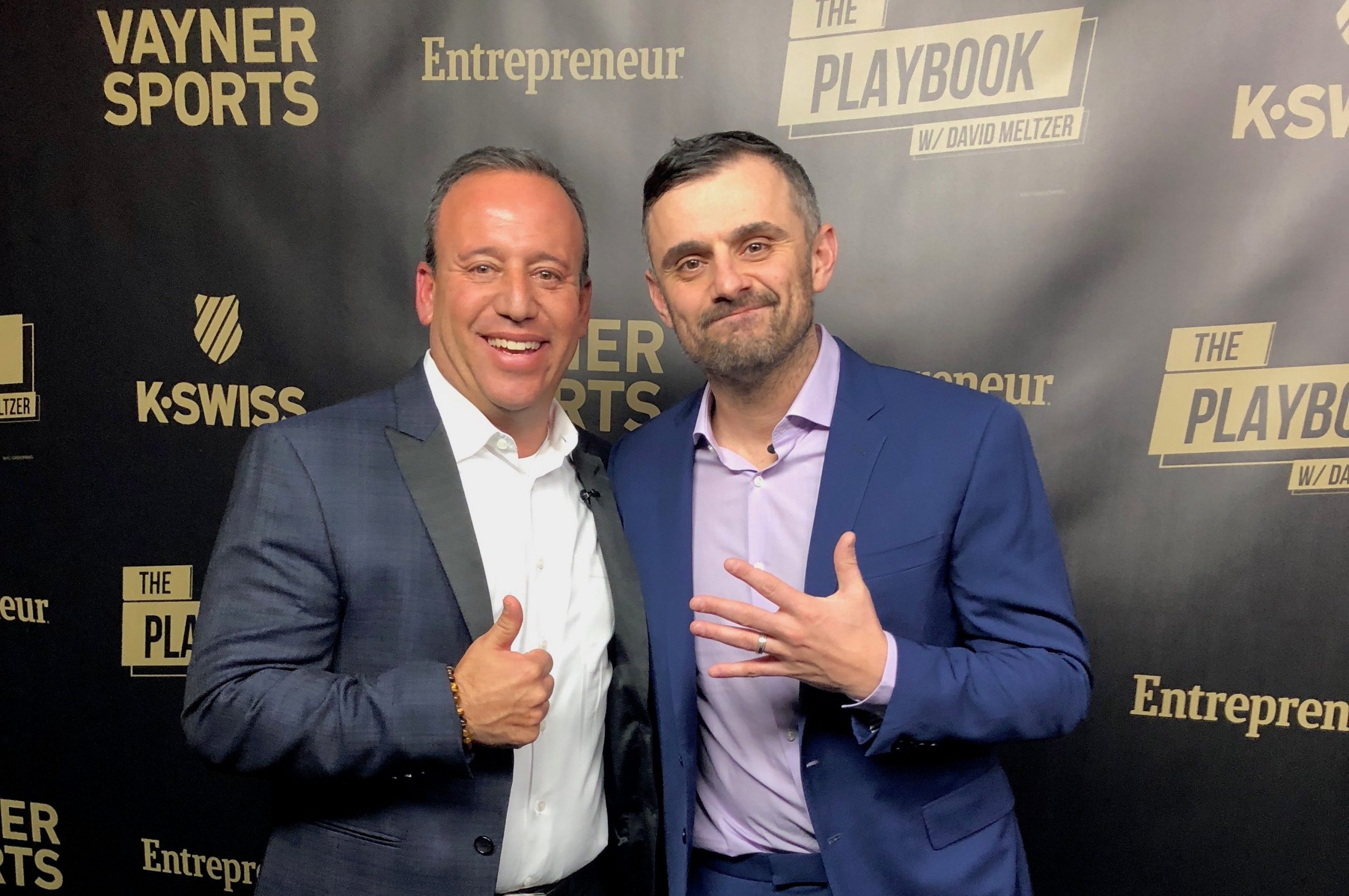
David Meltzer and Gary Vaynerchuk / image: ThriveGlobal
4. Which attitude is better for entrepreneurs: FOMO or JOMO?
I don’t believe fear is a motivator, although it does help some of us to focus, so I would never advise having a “FOMO attitude”.
To me, JOMO is preferable because it centres on happiness and joy. Having a JOMO attitude means that you have a positive perspective, as you are happy to be missing out, instead of a scarce or negative mindset that is associated with fear.
5. You are an experienced and successful entrepreneur. What is your #1 advice for new entrepreneurs?
There is one piece of advice that all entrepreneurs need to take into account: the most important thing for your company is to ensure you stay in business tomorrow. The most successful ventures are those who evolve over time.
Amazon, for example, began as an online bookstore before it evolved into one of the most powerful technology companies.
Google began as a search optimization tool before growing into the diverse powerhouse that the company is today.
This evolution could have never happened unless these companies kept their doors open for long enough to adapt and adjust, and that key is something that all entrepreneurs should consider every single day.
Join the Conversation
We’d love to hear what you have to say.
Get in touch with us on our LinkedIn Group, Facebook Group or Twitter.
Certified B Corporations – Using Business as a Force for Good
Certified B Corporations are a new type of businesses – they are using business as a force for good.
If you are looking for a way to prepare your business for the future, this article is for you.
Our failures are a painful but necessary teacher
The business landscape has a major influence on our world today. It is no longer acceptable to make money at any cost because it inevitably leads to an economic downturn. The latest example is the financial crisis which began in the USA in 2007 and lasted until 2009. We know now that selfish and greedy capitalism caused this recession with consequences felt worldwide. The housing industry collapsed, many Americans lost their homes and their jobs, over 230,000 U.S. businesses closed, the construction and manufacturing industries experienced double-digit losses in employment and European economies overall contracted.
The present is changing
The business environment encouraged and awarded a dog-eat-dog mentality among employees where there were no teams, but individuals competing with each other; where everyone had their own agenda and used all means necessary to come on top; where companies and corporations were looking to maximize profits by any means; where the interests of their shareholders came before the interests of their customers; where employees were easily replaced and rules were often bent at the expense of ethics and integrity.
What is the impact of your business?
Those days are long gone and fortunately, the business environment has learned its lesson.
We are living in the age of digital connectivity, transparency and instant access to news from all corners of the world.
Corporations and big companies no longer control the conversations around their products or their brand – their customers do.
We’re in the middle of a revolution and the customers are leading the charge. They are looking at the way businesses influence our world – for better or for worse. Is your business bad for the environment? Is your company producing plastic waste which has become a global problem? Are you helping communities to grow and have a better life? How do you treat your workers?
Certified B Corporations – using business as a force for good
In 2006, three friends – Jay Coen Gilbert, Bart Houlahan and Andrew Kassoy – left careers in business and private equity and created an organization dedicated to making it easier for mission-driven companies to protect and improve their positive impact over time – the Certified B Corporation.
Certified B Corporations are businesses that meet the highest standards of verified social and environmental performance, public transparency, and legal accountability to balance profit and purpose.
B Corps are accelerating a global culture shift to redefine success in business and build a more inclusive and sustainable economy.
Here are the main goals of B Corporations:
- Reduce inequality;
- Lower the levels of poverty;
- Create a healthier environment;
- Build stronger communities;
- Create more high-quality jobs with dignity and purpose.
B Corporations use profits and growth as a means to a greater end: positive impact for their employees, communities, and the environment.
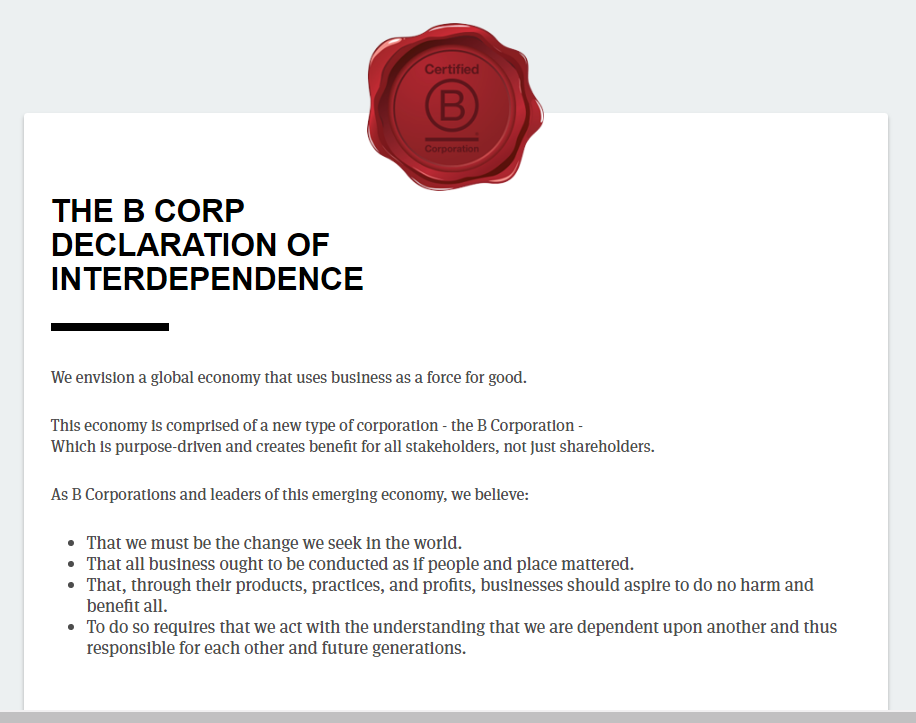
bcorporation.net
A business receives the B Corp Certification if it achieves a minimum verified score on the B Impact Assessment—a rigorous assessment of a company’s impact on its workers, customers, community, and the environment—and make their B Impact Report transparent on bcorporation.net.
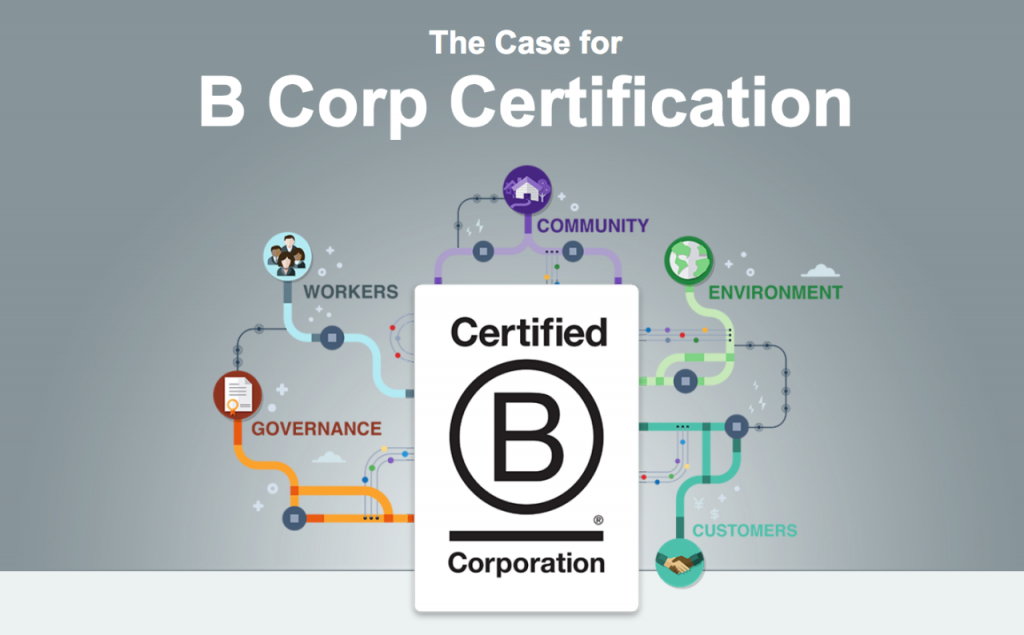
B Corp Facebook Page
Certified B Corporations also amend their legal governing documents to require their board of directors to balance profit and purpose.
There are currently 2788 B Corporations in 150 industries and 64 countries.
Here is how B Corporations stand out from other companies:
- They are 81% more likely to have transgender-inclusive healthcare coverage;
- The vast majority of B Corp employees are highly satisfied with where they work;
- B Corps are nearly 2x as likely for the majority of their managers to come from underemployed groups;
- They outperform other businesses by 16% on addressing climate change;
- 88% of service-industry B Corps allow flex-time schedules;
- They are 87% more likely to manage greenhouse gas emissions reduction;
- B Corps are 27% more likely to pay all of their hourly workers a living wage.
I first learned about the Certified B Corporation while researching Ecoalf, the first fashion brand in Spain to become a B Corporation. Sustainability is an important topic on BRAND MINDS blog and I addressed it by covering European companies which hold sustainability as one of their core values (you can find them in the Success Stories Series).
The second company I found was Certified B came as a surprise: Once Upon A Farm whose Chief Brand Officer is Hollywood actress Jennifer Garner. You can read about the company here: 3 Successful Businesses Founded by Hollywood Stars.
Here are other prominent B Corps and their overall B Impact score (which can range between 0 and 200):
- Patagonia Works, the leading outdoor apparel company which takes responsibility for their entire supply chain, pushing for just working conditions while protecting the environment (151); learn more about Patagonia in my article When Authenticity is Your Brand’s ….Brand
- Danone UK, North America, Egypt, Iberia and Canada, the food and beverages manufacturer (80);
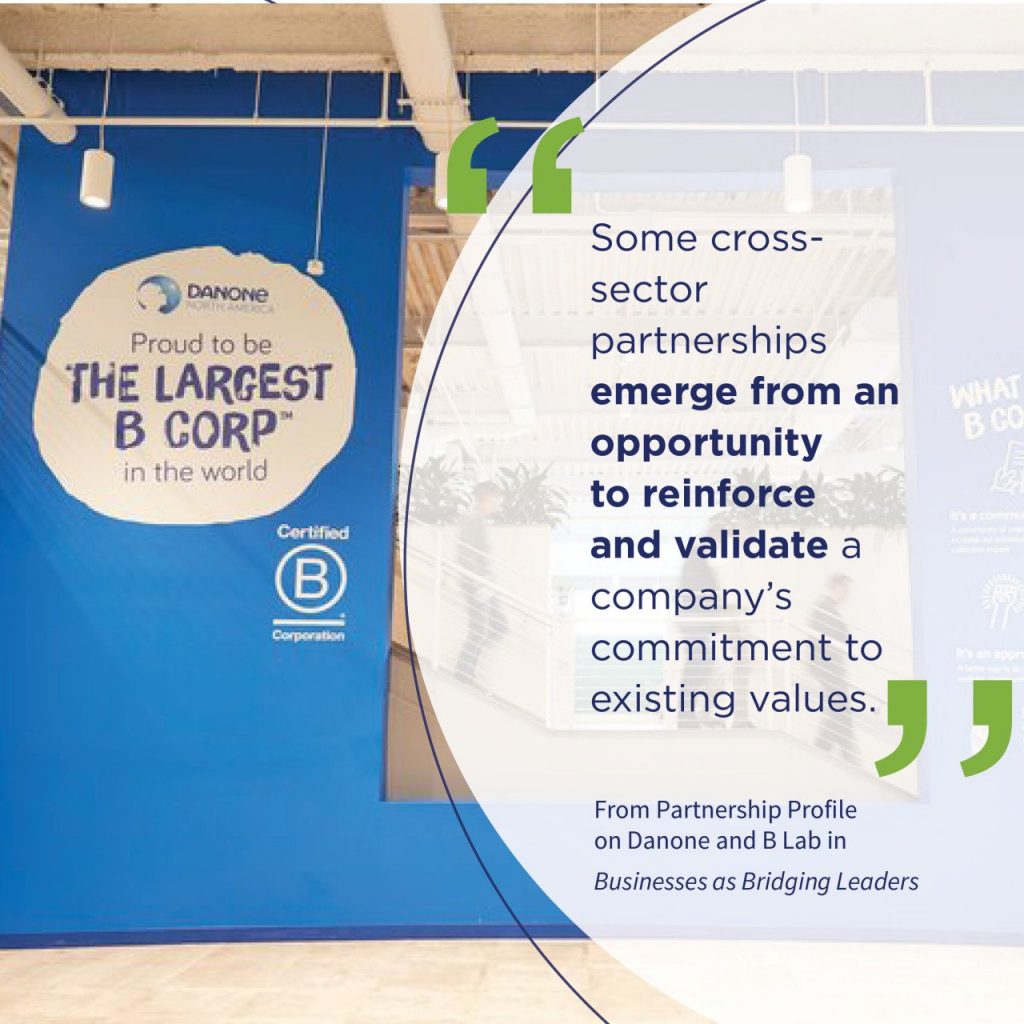
B Corp Facebook Page
- Hootsuite, the social media management platform (85); read Hootsuite: 5 Top Social Media Trends for 2019
- Natura, the Brazilian cosmetics company (120).
Do you want to measure your company’s impact on its workers, community, environment and customers?
Take the free B Impact Assessment!
Join the Conversation
We’d love to hear what you have to say.
Get in touch with us on Facebook Group and Twitter.
#ChildrensDay – 5 Kids Entrepreneurs We Should All Learn From
To celebrate this year’s #ChildrensDay, read this article on five kids entrepreneurs and the businesses they have created.
Kids are highly imaginative, creative, entrepreneurial and can achieve their dreams if they have their family’s help and support.
Here are 5 kids entrepreneurs and the businesses they have created:
Cory Nieves (15yr old) – CEO and founder of Mr Cory’s Cookies
15-years old baking prodigy Cory Nieves is the founder and CEO of Mr Cory’s Cookies. He founded his company at the young age of 6 when he decided to help his struggling single mother. Cory’s goal was to earn enough money to buy his mother a car so she wouldn’t have to take the bus to work.
Cory’s cookies are delicious and made from natural ingredients only and with no added preservatives. Media got word of his entrepreneurial flair and got invited to Ellen Degeneres’s show which certainly increased his brand awareness. Later on “The Profit” TV show host Marcus Lemonis saw a great opportunity and invested in Cory’s company.
He went a long way from baking in his mother’s kitchen – his factory bakes annually thousands of cookies in 12 flavours which are sold in famous stores like Bloomingdale’s.
“It wasn’t always easy. I learned a lot about a business by watching videos and through experience,” says Cory.
Moziah Bridges (19yr old) – CEO and founder of Mo’s Bows
19-years old Mo Bridges is the founder of Mo’s Bows, the company he started when he was 9.
Ever since he was little, he liked dressing up. He says he felt good when he looked good so he chose to wear suits and bow ties.
Struck by the lack of variety in men’s bow ties available in stores – which were downright boring – Mo set out to infuse their designs with creativity. He learned how to sew from his grandmother and then his company took off.
He was invited to many popular tv shows, he was featured in magazine articles and became the mentee of Damond John, one of the investors on Shark Tank.
When he was 14 he was hired by ESPN to be the channel’s fashion correspondent. His great performance has lead a year later to signing a business deal with the NBA.
Taylor Rosenthal (17yrs old) – CEO and founder of RecMed First Aid Kits
Taylor Rosenthal is the CEO and founder of RecMed, a company that makes first aid vending machines for use at theme parks and stadium.
He is now 17 but he started his company when he was 14. He came up with his idea when he noticed that when a kid got hurt on the baseball field, their parents weren’t able to find any first aid products such as band-aids to help their kid. So he invented the first aid vending machines.
Taylor learned to write and develop his business plan in a Young Entrepreneurs Academy class. The teenager launched his business from an Alabama incubator.
Taylor’s company hadn’t even started operations when he apparently received a $30 million buyout offer from a major healthcare company which he turned down. What did he base his decision upon? A vision of his company’s future:
“We kind of wanted to grow and develop the company a bit more and maybe later in the run, it would be worth a bit more.”
Mikaila Ulmer (14yrs old) – CEO and founder of Me & The Bees Lemonade
When she was 4, Mihaila was stung multiple times by bees. She became incredibly afraid of them so in order to help her overcome her fear, Mikaila’s parents encouraged her to learn more about bees.
During her study, she learned about their vital contribution to our ecosystem and also that pesticides were killing them off. That’s what made her decide to help the bees so she started Me & The Bees Lemonade. Her company sells lemonade made after her grandmother’s recipe which she improved by adding honey instead of sugar or artificial sweeteners.
When she was 11, Mikaila scored an $11 million deal with Whole Foods to sell her brand of lemonade. She is now 14 and looking to expand her business to new stores and write a book about how to become an entrepreneur.
Here is Mikaila at the 2016 United State of Women Conference introducing President Barack Obama:
Callum Daniel (10yrs old) – CEO and founder of iCodeRobots
When he was little, just 4, Callum loved playing with robots. Later on, he learned how to build them using code.
At 8 he wanted to help other children build robots. Because there were no robotics classes for children available on the market at that time, he decided to be the first to supply these classes so he set up iCodeRobots.
Callum’s company sells robotic classes for children, helping them gain the necessary skills and self-esteem to build and code robots. The company’s mission is to create future creators.
He is 10 now and has recently become an official LEGO presenter.
With loving support from their families, these five children achieved their dreams and started their own companies.
The internet is full of business information and advice for wannabe entrepreneurs, but business-focused content tailored specifically for children’s needs is not readily available.
Gary Vaynerchuk stepped in to fill this gap with his new animated show for kids: The Adventures of Lil’ Vee.
Join the Conversation
We’d love to hear what you have to say.
Get in touch with us on Facebook Group and Twitter.
8 Lessons For Business Success from Kevin Hart
Kevin Hart is a successful actor, stand-up comedian, producer, writer, and entrepreneur.
Here are 8 lessons for business success from Mr Hart:
Join the Conversation
We’d love to hear what you have to say.
Get in touch with us on Facebook Group and Twitter.
What Voice Search And AI Mean For Your Business
By 2020, around half of all searches will be conducted through voice search.
At least, that’s what the team at SEO Tribunal discovered when it conducted extensive research into the area.
Voice search is not a novel concept. If you have a smartphone, tablet, or even a laptop, you might already have used it yourself.
There’s no question that it makes searching for things online a lot simpler. After all, why type out a query when you can just ask your device to look for the answer?
If you’re not that clued up when it comes to voice search, the infographic below will tell you all that you need to know.
In this post, however, we’re more interested in how voice search and AI will affect businesses going forward.
Are you ready to learn more?
Advances In AI Have Made Voice Search Viable
The earliest versions of personal assistants were comparatively stupid by today’s standards. You had to get the exact keyword and spelling right to get close to getting the right answer. Even then the results were not very accurate.
Today however, AI is far more advanced, making voice searches a lot more accurate. In addition, virtual assistants like Siri, Cortana, Duplex etc. can collect results on their own and give you a quick summary of what they found.
The increase in the capabilities of these assistants has led to the creation of smart devices, such as smart speakers. These devices make full use of voice recognition software and can become a hub in the home.
All you have to do is to say the magic phrase, like Hello Google and your speaker will be activated. From there, you can run a voice search or tell your assistant to play music, for example.
What’s Does This Mean for Your Business?
Well, for starters, it means that your site must be optimized for voice search. But don’t let that stress you out too much, it’s not that much of a departure from what you are doing already. What you need to do is to start thinking as someone would if using a voice query.
Queries Are Changing
When we try to type out a query we tend to be a bit more economical with the number of words we use. We aim to use the minimum number of words because that means less typing. This further means that it’s a lot easier to narrow down the number of keywords to target.
With voice search, the opposite is true. We simply phrase the query as we normally would. It means that the number of keywords that might be used increases a lot. Also, the queries will take the form of questions, rather than simple phrases.
How to Prepare for Voice Search
It is actually a lot easier to optimize content for voice search than you might think.
You’ll need to think about the types of questions that people might ask in relation to your business, and then incorporate these into your site.
Setting up a comprehensive FAQ page is a good way to get started. But you can also start to incorporate more question style content on your site. So, for example, you could create a post titled,” What process do we use?” instead of “The Process We Use.”
It’s a subtle distinction, but one that better matches the format of queries to come. It will also work well when it comes to typed queries, so it’s not going to hurt your results now either.
Consistency Is Essential
There is one area where voice search could hurt business though, and that’s when it comes to the aggregated content provided.
Let’s say that someone asks Google for information about music shops in the area. Google will create a summary of the information based on numerous sources. What Google cannot do, however, is check that the information is correct. It could be a problem for you if there is info out there that is incorrect.
Say, for example, that your business was listed in a few online directories and then you moved. It isn’t a problem for you, you just update the information on your site. But Google will still pick up that old information and could present it in its findings. This means that the searcher could receive your old address and telephone number. And who do you think they’ll blame because the info is incorrect? That’s right – your business.
To get around this, run regular checks on your business’s information online in all sources and make sure that it is all correct and consistent.
In general, optimizing for voice means approaching things from a slightly different perspective, but it is not a major adjustment by any means.

Join the Conversation
We’d love to hear what you have to say.
Get in touch with us on Facebook and Twitter.
How to Scale your Business with these 6 Strategies
If you are an entrepreneur looking to scale your business, this article will provide you with 6 scaling strategies.
But before we talk about scaling, let’s establish the difference between growth and scale.

Growth vs scale
Growth means adding resources at the same rate that you’re adding revenue.
Scale is about adding revenue at a rapid rate while adding resources at an incremental rate.
Scaling growth is about creating business models and designing your organization in a way that easily scales in order to generate consistent revenue growth and avoid stall-points without adding a ton of extra cost and/or resources along the way.
Edisonpartners.com
Here are 6 strategies to scale your business
1. Focus on Renewals
[bctt tweet=”Depending on your business model, renewals are a smart way to scale your business.” username=”brand_minds”]
It’s the low hanging fruit wisdom: why struggle to acquire new customers when you can generate revenue from the people who already know your brand and use your product? Latest statistics say it’s five times less expensive to keep an existing customer than to attract a new one.
To boost your renewals and improve your retention rates:
- Look at your subscribers from a long-term relationship view;
- Adopt a customer-centric strategy and customer success;
- Build your company values with your customers at heart.
How can you use email to boost renewals?
Here are 4 tips via pure360.com:
1. Start early
Don’t wait until the last minute to send your renewal email to your subscribers! It’s best if you start eight months before the due date. This gives you plenty of time to do some customer inquiry and request feedback:
Are your customers happy with your product?
Do they have complaints that you need to solve?
Most importantly it gives you time to warm them up before you ask them to pay again.
2. Create a drip campaign
Change your approach: turn renewals into an important business objective.
Instead of writing one email, create a drip campaign:
- Write the copy of your email as carefully as any other piece of content;
- Emphasize the benefits of renewal;
- Incentivize your subscribers and use Cialdini’s 6 Principles of Influence.
Robert Cialdini is speaking at BRAND MINDS 2019
[bctt tweet=”Use email drip campaigns to boost your renewals.” username=”brand_minds”]
3. Extend deadline
Extend your subscription’s renewal. If your subscribers didn’t renew their subscription, find out the reason. If it’s a money problem, offer them a lower package; if it’s your product, find out what are their complaints and solve them.
4. Turn your renewals into brand ambassadors
Once your subscribers renew their subscription, give them a celebratory card or incentivize them to recommend your product to their friends.
[bctt tweet=”Brand scaling is driven by customers, not by businesses, large or small.” username=”brand_minds”]
2. Focus on users, not buyers
Harvard Business Review has recently conducted an online survey of more than 5,000 U.S. consumers and asked them about 50 different brands, both digital and traditional. The respondents were asked them about their perception, usage, preference, and advocacy for the brands.
Analysing the brands, the researchers observed two distinct directions:
- Traditional brands focus on positioning themselves in the minds of their customers, engaging them as buyers;
- Digital brands focus on positioning themselves in the lives of their customers, engaging them more as users than as buyers, shifting their investments from pre-purchase promotion and sales to post-purchase renewal and advocacy.
Here are the main findings of the survey:
- Purchase brands focus on creating demand to buy the product, while usage brands focus on creating demand for the use of the product;
- Purchase brands emphasize promotion; usage brands emphasize advocacy;
- Purchase brands worry about what they say to customers; usage brands worry about what customers say to each other;
- Purchase brands try to shape what people think about the brand along the path to purchase; usage brands influence how people experience the brand at every touchpoint;
- Usage brands think of customers less as one-time buyers and more as users or members with an ongoing relationship;
- Survey respondents showed more loyalty to usage brands and had stronger advocacy in the form of spontaneous recommendations to others;
- Survey respondents showed a higher preference for usage brands over competitors, not just in making the purchase but in a willingness to pay a premium in price: they were willing to pay a 7% premium, were 8% less likely to switch, and were 2x as likely to make a spontaneous recommendation of the brand.
3. Focus on developing your product
Developing a great product leads to growth and scaling for your business.
So look at your product as an ongoing process of improving, testing, developing etc.
[bctt tweet=”Spotify’s main reason of success relies on its disruptive product.” username=”brand_minds”]
Spotify’s Unique Value Proposition was to give users complete control and access to any song, on demand, for just $10/month, along with a free option that offered more than simple radio-style streaming—not to mention the fact that it was totally legal. It was an instant success because it filled a market gap.
Learn more: 3 Growth Hacks Spotify uses in Brand Strategy
4. Test and learn quickly
Don’t be afraid to submit your product to continuous testing, evaluate your results and improve your product accordingly – apply the 10,000-experiment rule to develop your product.
Giant tech companies have been developing fast and the driving force behind their achievements is the scientific method of experimentation. Google and P&G run 7000 experiments a year, Amazon – 2000 and Facebook – more than 100,000! (source: fastcompany.com).
[bctt tweet=”Apply the 10,000-experiment rule to develop your product.” username=”brand_minds”]
Canva’s management postponed the launch of its graphic design platform to the public until they had a great product. Through testing with their core subscribers they learned that their product had to perform a very important task which was not technical – empower their users, help them overcome their belief that they were not graphic designers therefore they didn’t have the skills and abilities to design.
Learn more: How Canva acquired 10 million users within 5 years
5. If possible, take advantage of social media platforms
Spotify used the power of social media platforms to scale their business.
In 2016, Spotify integrated with Facebook Messenger allowing people to share their Spotify songs or playlists directly within a chat box. Because each track, album and playlist have a unique URL, Spotify is sharing-friendly. This integration accelerated Spotify’s growth through referral traffic. Ultimately, millions of Facebook users also became advocates of the music platform because it filled the users’ desire to share their music socially.
6. Leverage Influencer Advocacy
Guy Kawasaki learned about Canva through one member of his social media team who was using Canva to create graphics for his posts. When the people at Canva noticed Guy’s social media graphics were designed with their tools, they contacted him and so he became Chief Evangelist of Canva. The reason Guy was attracted to Canva was that it “could democratise design just as Apple democratised computers and Google democratised information”.
Guy Kawasaki coming to Canva and supporting it helped the online design platform double its users’ numbers.
Wrapping Up
To scale your business implement these 6 strategies:
- Focus on renewals;
- Focus on users, not buyers;
- Focus on developing your product;
- Test and learn quickly;
- If possible, take advantage of social media platforms;
- Leverage Influencer Advocacy.
Join the Conversation
Get in touch with us on Facebook and Twitter. We’d love to hear your views!


